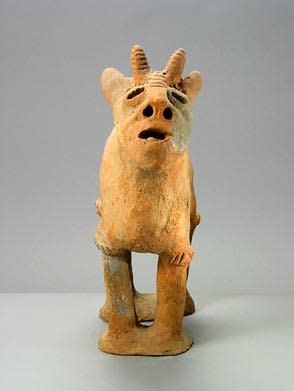African Art / Dakakari Terracotta Sculpture of a Goat, 18th Century CE - 20th Century CE
Terracotta
6.25 x 18 x 12.5
PF.5136 (LSO)
Further images
This schematic rendering of a goat was made by the Dakakari people. It is a large-bodied creature, with long legs, a short neck, an upturned face, pointed horns and sectorial...
This schematic rendering of a goat was made by the Dakakari people. It is a large-bodied creature, with long legs, a short neck, an upturned face, pointed horns and sectorial limbs that are marked with bands of decorated clay. The face is not at all naturalistic and even appears to have some human characteristics. There is a ridge down to the tail from the centre of the back. The clay is pale in colour, and very hard-fired. The position of the feet indicates that it may once have been attached to a spherical vessel; the reason for this is explained below.
The Dakakiri peoples of NW Nigeria are a little-studied group that are primarily known for their unusual funerary traditions. The standard practice was to bury individuals with a range of plain pottery for their use in the afterlife. However, it is the burials of the higher status individuals from the tribe – including their chiefs and their retinue – that give rise to the production of the Dakakiri’s major contribution to the corpus of African art history. Prestige individuals are buried in stone-lined shaft tombs; the sealed tops of these tombs are ringed around with stone walls to create a small enclosure.
Skilled potters are then commissioned to create sculptural vessels, with plain, spherical bases that are buried into the underlying soil, and with anthropomorphic or zoomorphic superstructures that commemorate the deceased. The deceased are venerated annually by pouring libations of maize flour or beer over the pots. The trade was usually kept within families; experience was all-important – the most prestigious potters were often post-menopausal women. Every person who dies in an elite family has another piece – or pieces – dedicated to them and placed within the superstructure over time, these collections can build up considerably, marking the development of the family throughout generations.
Goats were the staple diet for many of these groups, but the human characteristics of the face make this interpretation somewhat staid. It is likely to have performed some ritual of even just affectionate function for the dead. This is a rare and important piece of African art.
The Dakakiri peoples of NW Nigeria are a little-studied group that are primarily known for their unusual funerary traditions. The standard practice was to bury individuals with a range of plain pottery for their use in the afterlife. However, it is the burials of the higher status individuals from the tribe – including their chiefs and their retinue – that give rise to the production of the Dakakiri’s major contribution to the corpus of African art history. Prestige individuals are buried in stone-lined shaft tombs; the sealed tops of these tombs are ringed around with stone walls to create a small enclosure.
Skilled potters are then commissioned to create sculptural vessels, with plain, spherical bases that are buried into the underlying soil, and with anthropomorphic or zoomorphic superstructures that commemorate the deceased. The deceased are venerated annually by pouring libations of maize flour or beer over the pots. The trade was usually kept within families; experience was all-important – the most prestigious potters were often post-menopausal women. Every person who dies in an elite family has another piece – or pieces – dedicated to them and placed within the superstructure over time, these collections can build up considerably, marking the development of the family throughout generations.
Goats were the staple diet for many of these groups, but the human characteristics of the face make this interpretation somewhat staid. It is likely to have performed some ritual of even just affectionate function for the dead. This is a rare and important piece of African art.







